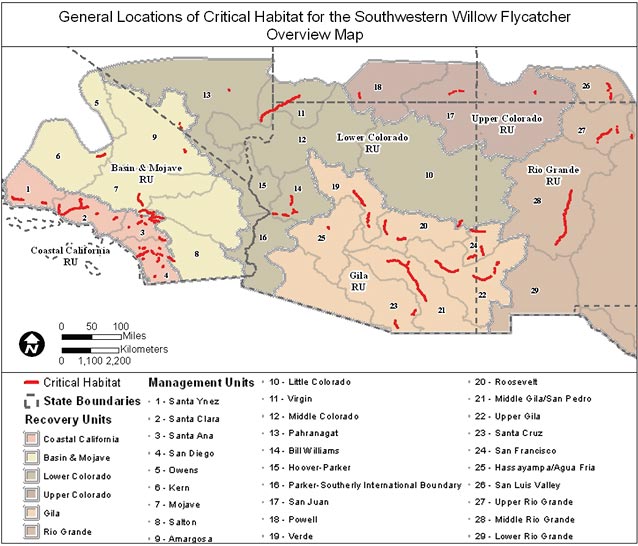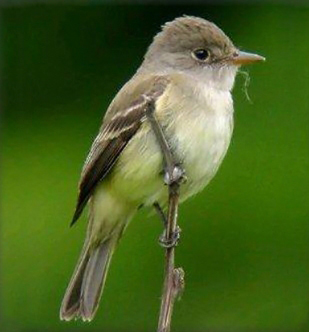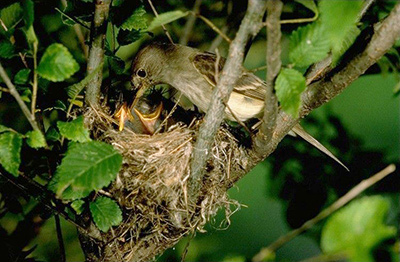The southwestern willow flycatcher is a federally endangered bird that breeds in dense riparian vegetation near surface water or saturated soils in the American Southwest.
Taxonomy
The southwestern willow flycatcher (Empidonax trailii extimus) is one of four subspecies of Empidonax trailii in the family of tyrant flycatchers (Tyrannidae). The three other willow flycatcher subspecies occupy different breeding ranges in the U.S. adjacent to the southwestern subspecies, with E. t. adastus to the north, E. t. trailii to the east, and E. t. brewsteri to the northwest along the northern Pacific coast.
Conservation Assessment

Source: U.S. Fish and Wildlife Service. Federal Register, 2013.
The U.S. Fish and Wildlife Service listed the southwestern willow flycatcher as a federally endangered species in 1995, and completed a plan for its recovery in 2002. By 2002, it was estimated that only 900 to 1100 pairs existed. That estimate has increased to 1299 territories as of the most recent rangewide survey, completed in 2007.
One of the primary reasons for the decline of this species is the loss and degradation of dense, native riparian habitats. Water impoundment (dams), water diversion for agriculture, and groundwater pumping all have altered streamflow and thus riparian vegetation. Other impacts to riparian habitat are caused by stream bank stabilization, riparian vegetation control, livestock grazing, off-road vehicle use, increased fires and urban development. The replacement of native riparian plants, such as cottonwood and willow, by nonnative tamarisk has changed the character of nesting habitat for the flycatcher, although flycatchers do successfully nest in tamarisk. Additionally, brown-headed cowbirds (Molothrus ater) can pose a significant threat to some local southwestern willow flycatcher populations through brood parasitism. Cowbirds have increased in range and abundance in response to increased irrigated agriculture and livestock grazing.
The U.S. Fish and Wildlife Service revised flycatcher critical habitat in January 2013, following previous designations in 1997 and 2005. The current critical habitat designation follows Recovery Plan goals, and identifies 1,975 stream kilometers in Arizona, New Mexico, and the southern portions of California, Nevada, Utah, and Colorado.
Description

USFWS Photo
The southwestern willow flycatcher is a small passerine, or perching bird, less than 15 cm (5.75 in) long from the tip of its bill to the tip of its tail. It weighs 11-12 grams. It has a brownish-olive to gray-green upper body, a whitish throat contrasting with a pale olive breast, a pale yellow belly, and two light wing bars. Males and females do not differ in plumage, but juveniles differ from adults by having buffy wing bars. If you are fortunate enough to view this bird up close, you will notice a completely yellow lower mandible and the lack of a conspicuous eye-ring. All willow flycatchers have a distinctive sneezy “fitz-bew” song, give “whit” and “brrrit” calls, and often flick their tails upward when perched.
Distribution
Southwestern willow flycatchers are neotropical migrants that breed in patches of riparian habitat throughout the American southwest. Their breeding habitat currently ranges from southern California, through southern Nevada, southern Utah, Arizona, New Mexico, southwestern Colorado, and historically included western Texas and extreme northwestern Mexico. They travel south to winter ranges in Mexico, Central America, and northern South America. While their current distribution is similar to their historic range, southwestern willow flycatcher population numbers have declined precipitously in response to the loss of suitable riparian habitat throughout the region.
Habitat Associations
Southwestern willow flycatchers require moist microclimatic and vegetative conditions, and breed only in dense riparian vegetation near surface water or saturated soil. While wet conditions are uniformly required, the structure and species of vegetation in which they nest vary by region and availability. The birds frequently build nests in nonnative tamarisk (Tamarix spp.), as well as in native willow (Salix spp.), typically in vegetation stands of 4–7 m in height. Nesting habitat patches can range widely in size, from as small as 0.6 ha to as much as 200 ha, although the majority of patches tend towards the smaller end of the range. They typically avoid narrow, linear patches less than 10 m wide.
Patches of riparian habitat are commonly used by willow flycatchers during migration, but may be smaller in size, with shorter, sparser vegetation structure than those used for nesting. In the winter, willow flycatchers use a variety of habitats, but appear to prefer semi-open brushy areas that are near water.
Life History
Southwestern willow flycatchers spend only 3–4 months of the year paired with a mate for the breeding season. They defend a small (typically <1 ha) breeding territory during this time, which is often clumped with nearby territories of other flycatchers in a semi-colonial fashion. They can occur singly or near other flycatchers during migration and on the wintering grounds.
Males often exhibit site fidelity by returning to the general area of the previous year’s breeding grounds. Because of the dynamic nature of riparian habitat, however, (a single flood can destroy an entire patch), flycatchers are known to move among sites in their breeding grounds, either within the same year or from year to year.
Reproductive Biology

Photo by S&D Maslowski
Southwestern willow flycatchers usually pair with a single mate during the breeding season, although polygyny (multiple female mates) has been documented at low rates.
Males arrive on breeding grounds in late April to early May to establish territories, approximately 1–2 weeks before the females arrive. After pairing, the female builds an open cup nest from leaves, grass, fibers, feathers and animal hair, approximately 8 cm high and 8 cm wide (outside dimensions). She meshes it into the fork of a tree branch, with the nest typically supported by several small-diameter upward-angling support stems. Nests are placed at an average of 4.6 m in height, but they can range from 1–12 m.
In late May to early June, the female lays 3–4 buffy eggs with brown markings in a circle at the blunt end of the egg. She incubates them for 12–15 days, and then both the female and male tend the young during the 12–15 day nestling stage. After fledging, young stay close to the nest for a few days, and do not leave the natal area for at least 14–15 days. During this time, both adults respond to the loudly begging fledglings by bringing them food. Some pairs will attempt to raise a second brood later in the season, particularly if their first nesting attempt fails. Nests with eggs have been observed as late as 30 August, with nestlings into mid-September.
Feeding Habits
Southwestern willow flycatchers feed primarily on insects, darting out in short flights to catch them in mid-air, or hovering to glean insects from foliage. They forage during the day, inside and above the canopy, along patch edges and openings in their territory, and above surface water, catching prey as diverse as flying ants to dragonflies. Hymenoptera (ants, bees, wasps, sawflies), Diptera (true flies, mosquitoes, gnats, midges), and Hemiptera (true bugs, cicadas, aphids, hoppers, shieldbugs) comprise much of the flycatcher’s diet.
References
Finch, Deborah M.; Stoleson, Scott H., eds. 2000. Status, ecology, and conservation of the Southwestern Willow Flycatcher. Gen. Tech. Rep. RMRS-GTR-60. Ogden, UT: U.S. Department of Agriculture, Forest Service, Rocky Mountain Research Station.
McCarthey, T. 2005. Willow Flycatcher (Empidonax traillii). Pages 302-303 in Arizona Breeding Bird Atlas, T.E. Corman and C. Wise-Gervais, eds. University of New Mexico Press, Albuquerque.
NatureServe. 2012. NatureServe Explorer: An online encyclopedia of life [web application]. Version 7.1. NatureServe, Arlington, Virginia. Available at http://www. natureserve.org/explorer (accessed 9 January 2013).
Paxton, E. H., M. K. Sogge, S. L. Durst, T. C. Theimer, and J. R. Hatten. 2007. The Ecology of the Southwestern Willow Flycatcher in Central Arizona-a 10-year Synthesis Report. USGS Open-File Report 2007-1381. Available at http:// sbsc.wr.usgs.gov/cprs/research/projects/swwf/reports.asp (accessed 25 March 2013).
Sogge, M. K., Ahlers, Darrell, and Sferra, S. J. 2010. A natural history summary and survey protocol for the southwestern willow flycatcher: U.S. Geological Survey Techniques and Methods 2A-10.
U.S. Fish and Wildlife Service. 2002. Southwestern Willow Flycatcher Recovery Plan. Albuquerque, New Mexico. i-ix + 210 pp., Appendices A-O.
U.S. Fish and Wildlife Service. 2012. Species Profile. Southwestern willow flycatcher (Empidonax trailii extimus). Environmental Conservation Online System. Available at http://ecos.fws.gov/speciesProfile/profile/ speciesProfile.action?spcode=B094 (accessed 18 December 2012).
U.S. Fish and Wildlife Service. 2013. Endangered and Threatened Wildlife and Plants; Designation of Critical Habitat for Southwestern Willow Flycatcher, Final Rule. Federal Register, Vol. 78 No. 2 (3 January 2013):344-534. Available at http://www.gpo.gov/fdsys/pkg/FR-2013-01- 03/pdf/2012-30634.pdf (accessed 9 January 2013).
Prepared by Sonya Daw, Southern Colorado Plateau Network I&M Program, 2013.
Last updated: October 5, 2016
